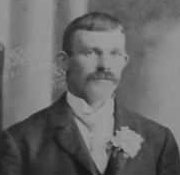As was typical of many small-town “architects” of the period, Frederick Stanford Starbard was a carpenter by trade and had no formal architectural training (note that one article notes that he went to the “best architectural schools in Boston”, however this has not been substantiated by any documentation). He was born July 1, 1863 in community of Lee, Maine. The son of a farmer, Starbard must have been anxious to leave the small town of Lee when he enlisted in the US Army at the age of 25 in 1888.
After serving four years he married Ada Alice Shipton (ten years his junior) in Black Hawk, Iowa on March 5, 1893. Together they had eight children. It was there in Waterloo, Iowa that Starbard became a skilled carpenter.
For reasons unknown by 1904 the family had moved to Walla Walla, Washington. At first he billed himself as a contractor, but by 1906 Starbard had begun to sell himself as an architect as well as contractor. He had an office in the Die Brucke Building. According to newspapers artciles, he designed and built “many fine modern” residences in the city, however specific projects are limited to the Quinn Building (1904), the Smitten Building (1907), and an addition to St. Paul’s School.
Census records indicate that by 1910, Starbard had moved the family to the community of Sprague in King County, and then on to Yakima by 1913. By 1915, the family had moved again, this time settling in Eugene, Oregon. He never billed himself as an architect after leaving Walla Walla, most likely due to increased competition from the growing number of specifically trained professionals.
While there he got caught up in a legal action regarding materials used in the construct an apartment building for Leroy F. & Hannah Straight. The court case lingered until 1918 and went all the way to State Supreme Court.
With his reputation tarnished, Starbard had already moved his family to Portland by 1916 where he continued to work as a contractor for several more years. His only known projects in the city are limited to the George Harvey House (1921); and the Vernon School (1932).
Starbard died in Portland, Oregon on April 25, 1935 at the age of 71.
By Michael Houser, State Architectural Historian - August 2020





